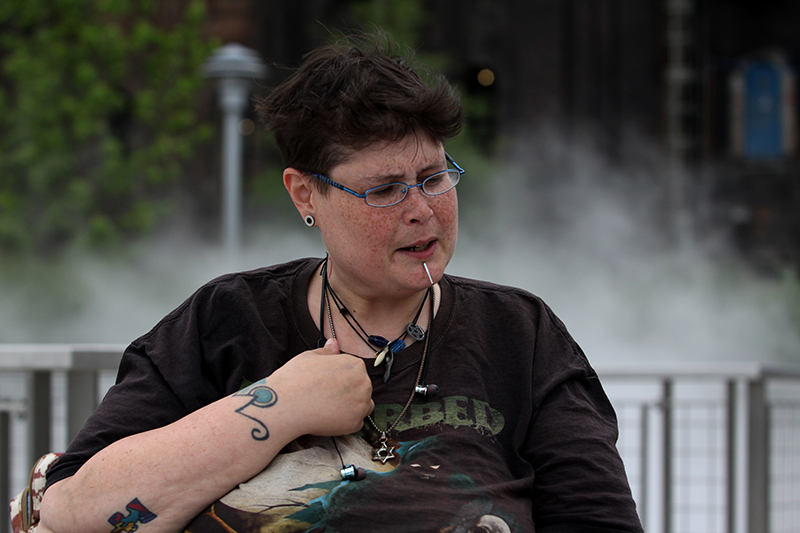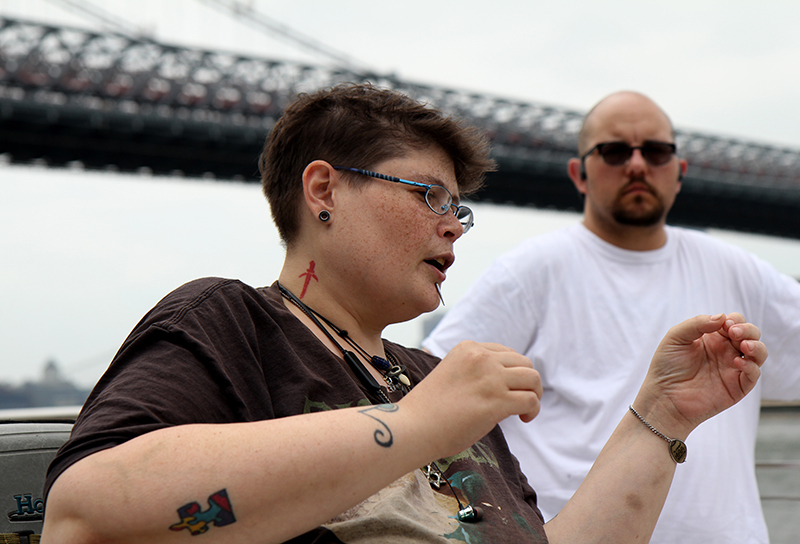Faith Alastair’s experience with homelessness is the first of three stories on LGBTQ homeless youth as reported by the JJIE’s New York City Bureau. They use gender-neutral pronouns.
NEW YORK — One clear, sunny spring afternoon in 1995, Faith Alastair was walking up Sixth Avenue near Eighth Street when three men jumped them, calling them a “faggot.” They suffered a black eye, a concussion and bruising all over. Alastair gave a fake name at Bellevue Hospital because they were homeless.
 At the time, they were a 15-year-old queer activist — protesting with the HIV advocacy group ACT UP, campaigning on the steps of City Hall and handing out condoms on the streets.
At the time, they were a 15-year-old queer activist — protesting with the HIV advocacy group ACT UP, campaigning on the steps of City Hall and handing out condoms on the streets.
Alastair had always had a strong sense of justice, but after the assault, they gained a greater awareness of the LGBTQ experience. “It wasn’t so much the incident itself, but rather the processing that I went through after the fact,” they said. “I was like, ‘Oh, this is not just me getting beat up. This is a systemic problem.’”
Many queer teens find themselves homeless. According to a recent study by Chapin Hall at the University of Chicago, 42% of the homeless youth population in New York City identifies as LGBTQ, which includes gender nonbinary teens.
LGBTQ youth often suffer from disapproval, exclusion and physical or emotional abuse at the hands of their parents. These kinds of traumas can force teens out of their homes and onto the streets. They then become susceptible to modes of survival considered criminal — resulting in an overrepresentation of queer homeless youth in the criminal justice system.
According to the Journal of Gender, Social Policy & the Law, LGBTQ youth make up 20% of all children in the juvenile justice system, even though they embody only 5 to 7% of the national youth population.
A shaky start
Alastair, now 39, has put themselves on a stable path. But their journey has been filled with obstacles — many of which resulted from the rejection they faced from their parents.
When Alastair was 8, their mother developed chronic pain and was diagnosed with Epstein-Barr, a type of herpes that can result in fevers, muscle pain and rashes. Over time, her use of painkillers turned into an addiction. “She would just continue to munch handfuls of these things,” they said. “All the way up until she died.”

MICHAEL TASHJI
Faith Alastair shares their stories of growing up homeless on the streets of New York City during the 1990s and 2000s.
They grew up in a Queens apartment. Their mother worked as a paralegal. Their father worked in computers and eventually volunteered with a police auxiliary. When Alastair was very young, their mother suffered a head injury that affected her personality. “She had health problems all my life that made her very bitter,” they said.
Their mother’s homophobia could have been related to that accident, Alastair said. When they were 12, their mother referred to them as a “butch” for the first time.
“I didn’t even know what it meant,” they said. “She did not approve of my attire and said, ‘Why do you insist on being such a butch?’ I lived next door to a library and so I went in, found out why, and then went ‘OK, well, there you go.’”
Their experience is not uncommon. According to a 2010 study by the Center for American Progress, 77% of clients at the Ali Forney Center, an organization exclusively serving LGBTQ homeless youth, had reported emotional or physical abuse at the hands of their families.
“If there’s this more subliminal kind of rejection of the child, because they’re picking up on some ‘difference’ that they don’t like in the child, that is impacting attachment,” said Susan Vitti, a clinical psychologist in private practice. “It’s going to result in an insecure model of attachment for that individual, and [they] carry that into adulthood.”
Thrown out
When Alastair was 15, their parents kicked them out of their apartment. “My folks locked the door on me after I disobeyed their directive to come home. And that was it,” they said, describing the night they became homeless.
“I was at a friend’s house — playing a game — they wanted me home at 11:00. I said, ‘I’ll be home at 11:30.’ They said, ‘No.’” Alastair came home to find the door deadbolted. They sat in their hallway all night until they heard their parents leave for work the next morning. Because the deadbolt only locked from the inside, they were able to enter the apartment with their key, pack a bag and leave for good.
Soon after that, Alastair met a man named Merlin who took them under his wing and became their mentor. He taught them how to survive on the streets: how to find food, how to panhandle, where they could stay warm and where they could sleep undisturbed. “All my best stories I tell people start with, ‘One time, me and Merlin …’” they said.
Yet panhandling was never enough — especially in the winter months. They turned to sex work in order to survive. “I was young enough, and I passed really well at the time. I could get away with giving blow jobs to guys who were looking for really young boys. And so that’s what I did,” they said.
Sex work is a common means of survival for LGBTQ homeless youth — they are nearly three times more likely to exchange sex for basic needs than their straight and cisgender counterparts.
“The underground economy puts them at greater risk,” said S J Dodd, a professor at the Silberman School of Social Work at Hunter College. “It exposes them to more police presence, and then who they are is also criminalized. So it sets them up.”
Finding their community
As they got older, Alastair found solace in the vampire community — a 1990s subculture of self-identified vampires. They welcomed anyone the outside world deemed different. Alastair and their friends were all tattooed with Aramaic symbols meaning “Child of Lilith,” named after their “housemother” — a title given to one of the leading members of the group. “There’s about 12 of us in total that have this tattoo,” they said.
The New York Police Department labeled their tattoo gang-related and had a file on them. “I have been stopped many, many times in the Ninth Precinct [East Village] for openly displaying” their tattoo, they said. “[But] not as many times as my vampire brethren with darker skin.”
The LGBTQ population faces a significantly higher risk of contact with the police than heterosexuals. According to the Williams Institute, a research entity at the University of California at Los Angeles School of Law that focuses on gender and sexual orientation policy, a national survey of LGBTQ individuals found that 73% of respondents had direct interaction with the police over the last five years. Of that group, 21% reported hostile or abusive attitudes from officers, while 14% had experienced verbal assault. Five percent were victim to sexual or physical assault by the police.
As Alastair spent the next decade or more living on the streets, their mother continuously tried to get them to come back home. But the older they got, the more self-sufficient they became. Their mother never changed the locks on the apartment door — part of an unspoken contract the two had for years. Alastair would take her up on the open door policy, and sometimes brought friends back to the apartment to eat and shower when their mother was not home.
Winning the lottery
In recent years, Alastair developed lipedema — a condition in which fat cells grow at an abnormally high rate, leaving them in a wheelchair.
In 2016, they and their wife found affordable housing through NYC Housing Connect, also known as the housing lottery, and moved into an apartment in Williamsburg, a Brooklyn neighborhood. “The system in New York City really does work, if you follow all of it from the beginning to the end,” they said. “We wound up qualifying for the apartment—barely.”
Fighting for equality
A year after their 1995 assault, Alastair attended a rally for the New York State Division of Human Rights to add gender expression to the language. They and 50 other activists boarded a charter bus in Manhattan and rode to the state capitol in Albany where they went door-to-door handing leaflets to policymakers.
Today they are the New York City chapter leader of the Pink Panthers Movement, an activist group committed to social justice for the LGBTQ community. They say the work is “so rewarding. Working with the Panthers has really given me an opportunity to do the kinds of work I’ve always done — fighting for our rights in the streets.”

Pingback: Homeless and Queer New Yorkers: Through the Lens - Youth Today
You have always had my heart when you use to talk to me abt certain things an yet I still learned some more from reading this I hurt cause I wish I could have been there ily